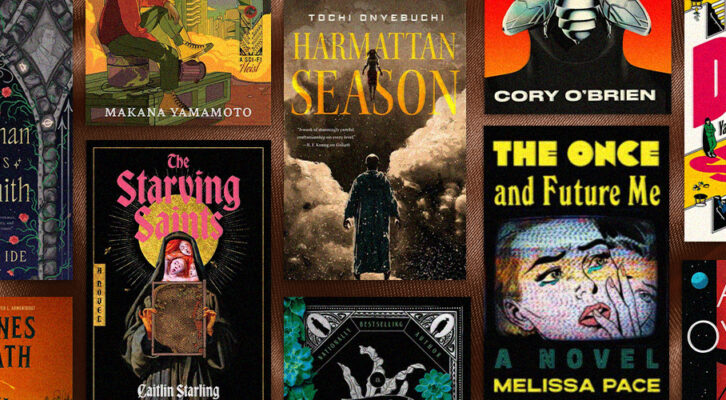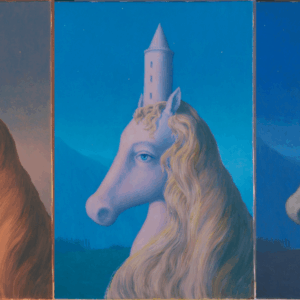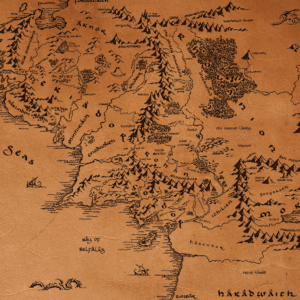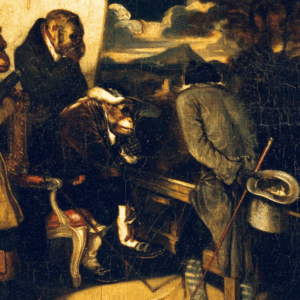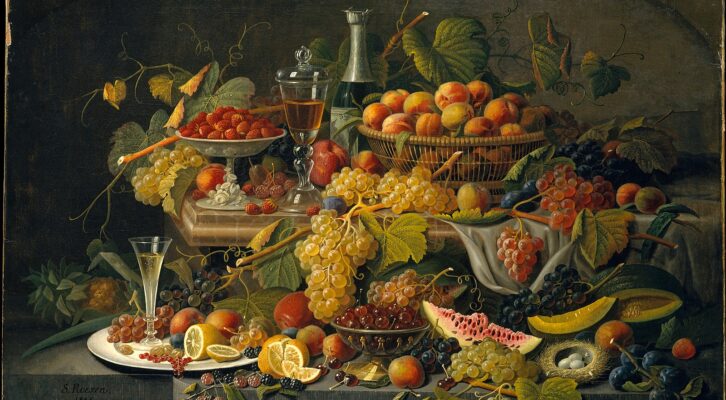
Face Pies, Holiday Turkeys, Finger-Feeding Critics: The Five Best Food Scenes in Literature
Adam Roberts Recommends Culinary Moments from Nora Ephron, Charles Dickens, Bryan Washington, and More
Feature image Rogers Fund, 1963.
Much like life, the best food scenes in literature arrive at the most emotionally charged moments. It’s one thing to eat a jelly doughnut; it’s another thing to eat a jelly doughnut after catching your husband in bed with your sister.
The circumstances that surround a meal are as important, if not more important, than the meal itself. Would you rather eat the most delicious food in the world with people you hate or mediocre food with people you love? I’m guessing most people would choose the latter.
When I set out to write my novel Food Person, I wanted to come up with a story where the food not only came on the heels of something dramatic, but amplified the drama itself. By focusing on the story of an aspiring food writer who agrees to ghost write a celebrity’s cookbook, food both provides the impetus for the action—two opposing forces attempting to collaborate in the kitchen—and reveals something about the characters themselves.
Isabella, the food writer, brings baked goods to the office every day as a way to avoid having to socialize with her co-workers; Molly, the celebrity with a cookbook deal despite hating food, mercilessly hacks apart a head of kale on Instagram live, dressing it only with lemon juice.
Brillat-Savarin famously wrote, “Tell me what you eat, and I’ll tell you who you are.” The best food scenes in literature do exactly that: they illuminate the characters and the story by way of the kitchen. Here are five of the best.
*

#1: The “Pie-in-the-Face” Climax of Nora Ephron’s Heartburn.
As soon as you mention the words “food” and “literature,” the mind instantly goes to Nora Ephron’s Heartburn. Is there a better book that integrates food so seamlessly—or more hilariously—into its narrative? I’m not sure there is.
The autobiographical story about Ephron’s marriage to Carl Bernstein and the affair that he carries on while she’s seven months pregnant is full of food riffs and recipes—including Lilian Hellman’s pot roast—and leads to the indelible moment where Nora (or her surrogate, Rachel Samstat) throws a freshly made key lime pie into her cheating husband’s face.
Part of what makes it so effective is the ambivalence with which she throws it: “If I throw this pie at him, he will never love me. But he doesn’t love me anyway. So I can throw the pie if I want to.” It lands “mostly on the right side” of Mark’s face, “the cream and the lime filling” clinging to “his beard and his nose and his eyelashes,” and instead of devolving into a fight, the episode ends with laughter.
The way Ephron juggles the emotions, the comedy, the anger, and the dessert in this scene is nothing short of masterful.

#2: Christmas dinner at the Cratchits in Charles Dickens’ A Christmas Carol.
When the Ghost of Christmas Present arrives at Scrooge’s door in Charles Dickens’s iconic Christmas tale, Scrooge enters his room to find “heaped up on the floor” piles of “meat, suckling-pigs, long wreaths of sausages, mince-pies, plum-puddings, barrels of oysters, red-hot chestnuts, cherry-checked apples, juicy oranges, luscious pears, immense twelfth-cakes, and seething bowls of punch, that made the chamber dim with their delicious steam.”
Right out of the gate, food becomes an important symbol of all the splendor there is to life – splendor that Scrooge has, thus far, shut out. Continuing on their journey, the ghost leads Scrooge through the market and Dickens waxes rhapsodic over “pears and apples, clustered high in blooming pyramids…bunches of grapes, made in the shopkeepers’ benevolence to dangle from conspicuous hooks, that people’s mouths might water gratis as they passed.”
All of this leads to Scrooge’s arrival at his clerk’s house, Bob Cratchit’s, where the plenty that we’ve just experienced is contrasted by the “small atom of a [goose] bone upon the dish.” And yet the family behaves as if they’re at the most plentiful of feasts: as Dickens puts it, “There never was such a goose….Its tenderness and flavor, size and cheapness, were the themes of universal admiration.”
In this moment, food goes from being a symbol to an agent of change: as soon as he has his awakening, what’s the first thing Scrooge does? He sends a “prize turkey” to the Cratchits.

#3: The critic in the kitchen in T.C. Boyle’s “Sorry Fugu” from If the River Was Whiskey.
In the contest of great short stories about food, this one, quite literally, takes the cake. T.C. Boyle is such a talented writer, his personal checks are probably more interesting to read than most grad students’ first novels. Here you have an almost obvious set-up: a desperate to be noticed Italian chef named Albert is praying for the city’s most cut-throat critic, Willa Frank, to come evaluate his food.
The story begins with some of her cruelest salvos: “Limp radicchio.” “Sorry fugu.” “A blasphemy of baby lamb’s lettuce, frisee, endive.” “A coulibiac made in hell.” On the first night that Willa Frank finally shows up, Albert’s kitchen is in disarray: a waiter is late, the pastry chef falls behind, the cream’s gone sour, and the dishwasher storms off in a rage. Willa always brings her friend “The Palate” who sniffs the food and pushes it away.
The second visit doesn’t go much better. It all builds to the third visit when, upon hearing that The Palate’s favorite foods are simple fare like steak, potatoes, and peas, Albert contrives a plan that lures Willa Frank, by herself, into the kitchen. Suddenly the artist is face-to-face with the critic and he begins feeding her squid rings in aioli with his fingers.
It’s weirdly erotic, psychologically astute, and dramatically thrilling, especially for any creative person who wishes they could confront their harshest naysayer with the purest version of their talent.

#4: The post-wolf hunt repast in Leo Tolstoy’s War and Peace.
I swear this isn’t a #humblebrag that I’ve read War and Peace. It was the pandemic and I wanted to challenge myself after listening to Patti LuPone’s memoir and beating Legend of Zelda: Breath of the Wild. Twelve hundred and fifteen pages later, I was glowing from my accomplishment and also Tolstoy’s generous, rich, amusing, and loving prose.
Shocking no one, the scene that stays with me the most has to do with food: after a violent and rousing wolf hunt, Natasha and her brother Nikolai are invited to a distant uncle’s house to stay the night. Upon entering a study that “smelled strongly of tobacco and dogs,” they are presented with “an herb cordial, liqueurs, mushrooms, flat cakes made from dark flour and buttermilk, honey in the comb, still and foaming mead, apples, fresh and roasted nuts, and nuts in honey.”
This is presented by a live-in housekeeper who, it seems, is also the uncle’s common-law wife. As Tolstoy writes: “It all spoke of juiciness, cleanness, whiteness, and a pleasant smile.” This sequence, which culminates with the uncle playing guitar and Natasha crying for “more, more!,” is a perfect embodiment of the book’s larger themes contrasting the ravages of war with the sweet sensations of life. And honestly, that meal sounds really good?

#5: The shrimp omelet in Bryan Washington’s Memorial.
Imagine having your mother-in-law come to visit and then your boyfriend bolts for another country. That’s precisely what happens at the start of Bryan Washington’s novel Memorial, where Benson, a daycare teacher, is left behind with his boyfriend Mike’s mother Mitsuko, who’s visiting from Japan.
Benson and Mitsuko are awkward around each other at first; but that awkwardness begins to melt away one morning when Mitsuko asks Benson: “Do you eat?” and Benson answers, “I do.” Most of the food scenes on my list occur at the ends of the stories, but here food sets the story into motion: Mitsuko blitzes shrimp, eggs, flour, and honey in a food processor, drops the mixture into a skillet, dabs everything with soy sauce, and folds the batter gradually.
Then, the gesture that really kicks things off: “She fills a bowl with some pickled cucumbers, with a plate for the omelette, leaving another one out for me.” While they eat, Mitsuko asks: “How long have you been sleeping with my son?” Like a magic spell, Mitsuko’s cooking tears down the wall and these two absolute strangers can finally begin to connect.
Honorable mentions:
- No list about food in literature can be complete without Marcel dipping the madeleine in the tea in Proust’s Swann’s Way, kicking off seven volumes of memories that even the most ardent madeleine lover might have trouble getting through. (I quit after a hundred and eighty-five pages.)
- Not sure which is more criminal: leaving Portnoy masturbating with a liver off of this list or including it. Either way, the iconic scene from Philip Roth’s Portnoy’s Complaint is a seminal moment in literature.
- Does doing the dishes count? It does when it’s Pnin in Nabokov’s masterpiece, dropping a nutcracker into the sink where the “large bowl of brilliant aquamarine glass,” a gift from his former wife’s son, sits helplessly among the suds. Thankfully, it was only a goblet that cracked. He puts the bowl back on a “high, safe shelf” where the “sense of its security there communicated itself to his own state of mind.” And to think all of this could have been avoided with a functional dishwasher.
______________________________

Food Person by Adam Roberts is available via Knopf.
Adam Roberts
Adam Roberts is the author of The Amateur Gourmet, Secrets of the Best Chefs, and Give My Swiss Chards to Broadway. He started his food blog The Amateur Gourmet in 2004, and also hosts the podcast Lunch Therapy. Roberts has also written for The Washington Post and The Los Angeles Times, and for film and television. He lives in Brooklyn with his husband and their dog Winston. Food Person is his first novel.











